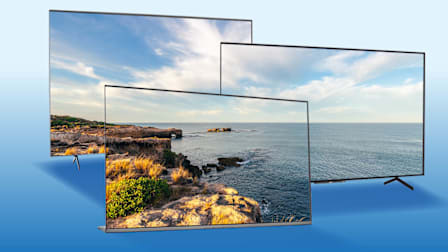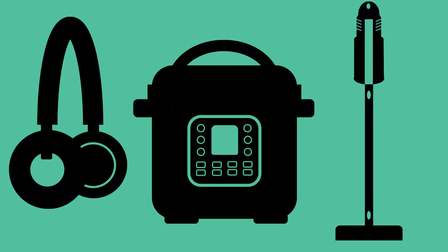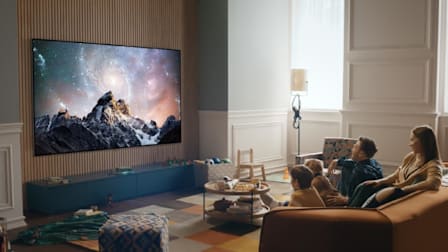How to Hear Your TV Better
Having trouble catching dialogue in TV shows? Here's how to use settings, headphones, and specialized devices to enhance the audio.
When you shop through retailer links on our site, we may earn affiliate commissions. 100% of the fees we collect are used to support our nonprofit mission. Learn more.

It’s a common problem: People with hearing loss have trouble watching television. Even with the volume at maximum level, many of them can’t quite make out the dialogue.
For me, this problem hits close to home.
In the later years of my dad’s life, he struggled to understand what was being said on TV shows. When I called or visited him, the TV was often at full blast. And yet he complained that it really didn’t help him follow the onscreen conversations. It simply added another layer of commotion.
“We see this issue quite a bit, especially with our older patients,” says Meredith Scharf, AuD, of Manhattan Audio in New York. “It’s not just volume; it’s clarity anytime there’s a high background level of noise. It can be with speech and conversations, as well as with TV.”
Hearing loss can also be an issue for children and younger adults who may be using laptops and other mobile devices to watch TV shows and movies.
“The younger generation, like my daughter—who is hard of hearing—often doesn’t own a television and streams from their laptops,” says Janice S. Lintz, a hearing loss advocate in Washington, D.C. There are solutions for those types of listeners, too, she says.
If you’re having trouble, it’s always a good idea to get your hearing checked by an audiologist or other specialist. Meanwhile, you don’t need to give up on your favorite programs.
In the sections below, we break down many of the options and strategies that can help you hear your TV more clearly.
Of course, there’s always the closed caption function on your TV, cable box, or laptop. My dad found that helpful, and my wife and I did, too, when our son was an infant and we wanted to watch TV while he slept.
Change TV Audio Settings
Many people aren’t comfortable playing around with a TV’s settings, but it’s worthwhile if you suffer from hearing loss. Most televisions have several audio settings that can help, and it’s almost impossible to mess things up. If you don’t like the result, you can just restore the manufacturer’s default settings.
To begin, go to the TV’s menu, click the Settings icon or label, and look for an item labeled Audio or Sound.
Now look for the available presets. Some TVs have a setting specifically designed to enhance dialogue, which can be helpful. These settings may be called Dialogue or Speech Boost; some sets may use brand-specific terms, instead, such as Voice Clarity, Voice Enhancement, or Clear Voice.
Buy a Soundbar Speaker
Soundbars are a great way to improve TV sound, especially now that many models come with built-in voice-enhancement technology.
For example, Sonos soundbars, including the $200 Sonos Ray, have several Speech Enhancement settings that boost the audio frequencies associated with the human voice. The company’s priciest model, the $1,000 Sonos Arc Ultra, adds artificial intelligence to detect and clarify dialogue over background sounds.
Many Samsung models have a Voice Enhancement mode that emphasizes the frequencies associated with the human voice. LG soundbars offer either Clear Voice or Clear Voice Pro modes, designed to enhance dialogue clarity by reducing background noise.
Zvox markets several sound bars—including the $200 AccuVoice AV157 TV Speaker—designed specifically to improve dialogue intelligibility. In our tests, its overall sound quality was only fair. But it has 12 levels of dialogue boost, including AccuVoice settings that try to mimic the function of a hearing aid by isolating voice frequencies and lifting them out of background sounds. Another feature, called SuperVoice, adds another layer of enhancement by further separating voices from other sounds and compressing or leveling the sound.
Become a member of Consumer Reports to get access to our TV Screen Optimizer, which will help you get the perfect picture on your TV in just minutes. Join today to get started.
Use Wireless Headphones
Nearly all new TVs are outfitted with Bluetooth, which lets you send the sound straight to a pair of wireless headphones once they’re paired. If your set lacks this feature, you can buy an inexpensive Bluetooth adapter that plugs into your set’s audio port for use with Bluetooth headphones. Some headphones are made specifically for enhancing TV dialogue. In addition, many general-purpose headphones and earbuds, including the Apple AirPods Pro, have phone apps that let you enhance the sound in the middle to higher frequencies where most dialogue takes place.
You can also try stethoscope-style headphones, called stethosets or TV listeners, designed to enhance TV sound for people with hearing loss. They work by boosting the frequencies common to dialogue.
TV Ears is probably the best-known manufacturer of these, but other companies, including Sennheiser, also make this type of system.
TV listeners generally include a small base unit with a transmitter that you connect to the TV. The transmitter is paired to a pair of earphones linked by a horseshoe-shaped wire to a receiver.
Connect Your Hearing Aids to the TV
There are several ways to connect hearing aids to your television. Many modern Bluetooth hearing aids can pair with your TV via its Bluetooth; you then fine-tune the sound using the hearing aid’s app. But not all Bluetooth hearing aids can connect directly with a TV since there are various specialized Bluetooth protocols.
A popular alternative is to use a media streamer, which plugs into the set and then transmits TV signals to your hearing aid. But streamers often only work with a specific brand of hearing aid. That can be an issue in homes where more than one person has hearing loss, according to Lintz. “Potentially, each member will need their own individual streamer, and they might need to be replaced when a new hearing aid is purchased,” she says.
Another option is a loop system. There are both headset systems and installed loop systems. A room loop, aka an induction loop, is often used in theaters and movie houses, but it can be set up on a smaller scale in your home.
In this setup, a wire is placed around the perimeter of the room, and electromagnetic TV signals are picked up by a tiny receiver (called a T-coil or telecoil) built into most hearing aids. One benefit to this approach is that multiple listeners can tune in, provided they each have a compatible receiver in their hearing aids. Another plus: You get good reception no matter where you are in a room, so you don’t have to worry about moving around.
































